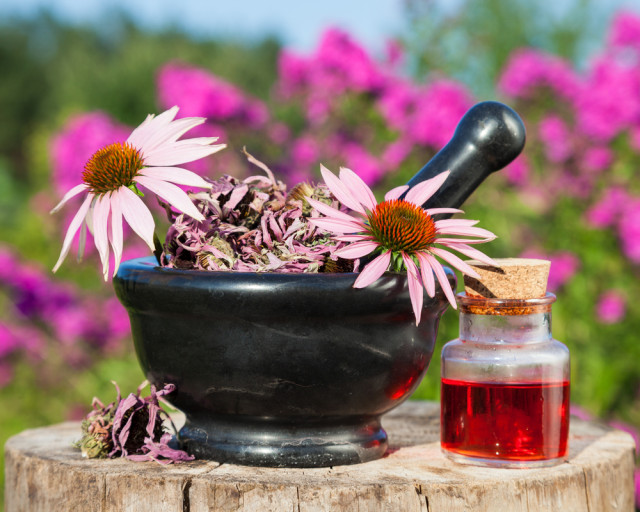Written by Green Diva Brigitte Mars
Listen to this Green Divas Health & Beauty podcast episode to learn how to make our own herbal tinctures…then read on for more!
Easy to store and use, tinctures have traditionally been started on the new moon so that the energy of the moon can draw out the properties of the herbs.
Preparation
Prepare the herbs by chopping or grinding them. You may tincture several herbs together if you are creating a formula. Put them in a jar and cover with about an extra inch of brandy or vodka. This will help to preserve the herbs and extract both the water-soluble and alcohol soluble properties.
Alcohol must be at least 50 proof to have good preservative qualities. Vodka is the purest grain alcohol. Water is a good medium to extract gums, mucilage, saponins and tannins, but not so good for oils and resins.
Alcohol is ideal for extracting fats, resins, waxes and most alkaloids. It is an excellent preservative and is quickly assimilated. Tinctures made in alcohol will last for many years. The substance used to extract the herbs is known as the menstrum. The herbs you are tincturing are known as the mark.
Up-keep
Shake daily. Strain after a month, first with a strainer and then through a clean undyed cloth, squeezing tightly. Pressing the herbs through a potato ricer, while still in the cloth can be helpful. Bottle in amber glass bottles. Compost the mark. Label and date. Store away from heat and light. Take tinctures by putting one dropperful in a bit of hot water.
Alternatives
Tinctures may also be made using vegetable glycerin rather than alcohol. This is best when making tinctures for those that are alcohol intolerant as well as for children, pregnant and nursing mothers. Glycerin is both a solvent and preservative that has effectiveness somewhere between water and alcohol.
It is naturally sweet, pleasant tasting and helps to extract mucilage, vitamins and minerals and tannins from plant material. It is good for herbs high in tannins and doesn’t extract resins well. It is slightly antiseptic, demulcent and healing when diluted.
Glycerites are usually prepared using 1 part water to two parts glycerin. Glycerites have a shorter shelf life than tinctures prepared with alcohol, about one to three years.
Apple cider vinegar, preferably organic can also be used as a menstrum. Look for a vinegar with 5.7% acetic acid or thereabouts for a long shelf life. It is also a digestive tonic and can be used to season food. Warm the vinegar first before pouring over the herbs. Avoid using a metal id or it will rust. This type of tincture will have a shelf life from six months up to four years.
Bonus:
Here’s the latest episode of The Green Divas Radio Show for more on green and healthy living…
Listen to the latest Green Divas Radio Show—and other green and healthy living podcasts—daily on GDGDRadio.com (or get the GDGD Radio app)! Green, free radio!
[dynamic-sidebar id=’Custom Widget 2′]
 Brigitte Mars is an herbalist and nutritional consultant of Natural Health with over forty years of experience. She teaches Herbal Medicine at Naropa University, Bauman College of Holistic Nutrition, The School of Natural Medicine, Living Arts School, and Integrative Earth Medicine in Colorado. She has taught at Omega Institute, Esalen, Kripalu, and The Mayo Clinic, She blogs for the Huffington Post and Care2. She is a professional member of the American Herbalist Guild. Visit her website and Facebook Page for more!
Brigitte Mars is an herbalist and nutritional consultant of Natural Health with over forty years of experience. She teaches Herbal Medicine at Naropa University, Bauman College of Holistic Nutrition, The School of Natural Medicine, Living Arts School, and Integrative Earth Medicine in Colorado. She has taught at Omega Institute, Esalen, Kripalu, and The Mayo Clinic, She blogs for the Huffington Post and Care2. She is a professional member of the American Herbalist Guild. Visit her website and Facebook Page for more!
Asst. Ed. Green Diva Grace | Images via Shutterstock
